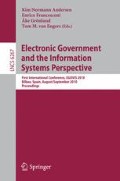Abstract
Innovating Government is high on the agenda and has been proven as successful by using Web 2.0. This label includes a new wave of web-based applications that rely on the concept of the user as a producer. Web 2.0 provides means to create a better Government. As first point, improvements are regarded that are based on providing feedback to agencies. Examples include service ratings, law enforcement and budget allocations. A next type of improvements concerns citizen participation in order to reconnect citizens with politics and policy making as to improve responsiveness. For this aim social media are great in sustaining all kind of civic society activities. Prominent examples include campaigning, petitioning, monitoring and urban planning. Another way is agency staff persons using the Web 2.0 for cross-agency collaboration. Collaboration at large leads to good practice exchange and knowledge management.
Access this chapter
Tax calculation will be finalised at checkout
Purchases are for personal use only
Preview
Unable to display preview. Download preview PDF.
References
Leitner, C. (ed.): eGovernment in Europe: The State of Affairs. Presented at the eGovernment Conference in Como, EIPA, Maastricht (2003)
Millard, J. (ed.): European eGovernment 2005-2007: Taking stock of good practice and progress towards implementation of the i2010 eGovernment Action Plan. Presented at the eGovernment Conference in Lisbon, EC Brussels (2007)
Scholl, J., Janssen, M., Traunmüller, R., Wimmer, M. (eds.): Electronic Government, Proceedings EGOV 2009 (within DEXA 2009 in Linz). LNCS, vol. 5693. Springer, Berlin (2009)
Wimmer, M., Scholl, J., Janssen, M., Traunmüller, R. (eds.): Electronic Government, Proceedings of Ongoing Research, General Development Issues and Projects of EGOV 2009 (within DEXA 2009 in Linz). Trauner Verlag, Linz (2009)
Osimo, D.: Web 2.0 in Government: Why and How?, http://www.jrc.es/publications/pub.cfm?id=1565
Fages, R., Sanguesa, R. (eds.): State of the art in Good Practice Exchange and Web 2.0 (September 2007), http://www.epractice.eu
Habbel, F., Huber, A. (eds.): Web 2.0 für Kommunen und Kommunalpolitik. Verlag Werner Hülsbusch, Boizenburg (2008)
Traunmüller, R., Wimmer, M.: KM for Public Administration: Focusing on KMS Feature Requirements. In: Karagiannis, D., Reimer, U. (eds.) PAKM 2002. LNCS (LNAI), vol. 2569, pp. 314–325. Springer, Heidelberg (2002)
COE, Council of Europe, Good Governance in the Information Society, http://www.coe.int/T/E/Integrated_Projects/Democracy/
COE, Council of Europe, Reflections on the Future of Democracy in Europe (September 2008) ISBN 92-871-5835-5
Smith, S., Macintosh, A., Millard, J. (eds.): Study and supply of services in the development of eParticipation in the EU (May 2008), http://www.european-eparticipation.eu
Tholeifsdottir, A., Wimmer, M. (eds.): Report on current ICT’s to enable Participation (2006), http://www.demo-net.org
Author information
Authors and Affiliations
Editor information
Editors and Affiliations
Rights and permissions
Copyright information
© 2010 Springer-Verlag Berlin Heidelberg
About this paper
Cite this paper
Traunmüller, R. (2010). Web 2.0 Creates a New Government. In: Andersen, K.N., Francesconi, E., Grönlund, Å., van Engers, T.M. (eds) Electronic Government and the Information Systems Perspective. EGOVIS 2010. Lecture Notes in Computer Science, vol 6267. Springer, Berlin, Heidelberg. https://doi.org/10.1007/978-3-642-15172-9_7
Download citation
DOI: https://doi.org/10.1007/978-3-642-15172-9_7
Publisher Name: Springer, Berlin, Heidelberg
Print ISBN: 978-3-642-15171-2
Online ISBN: 978-3-642-15172-9
eBook Packages: Computer ScienceComputer Science (R0)

